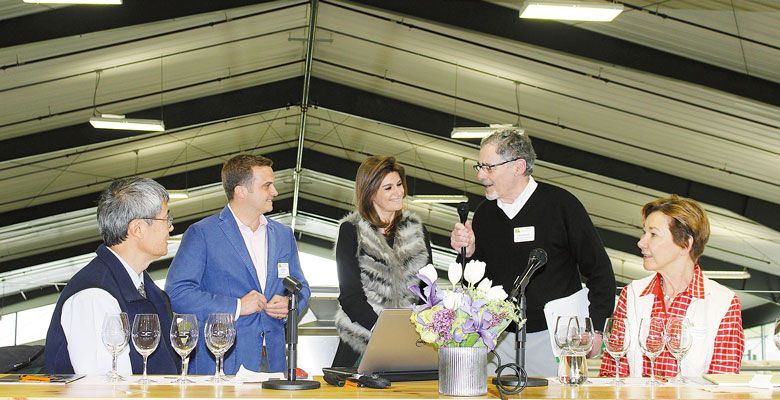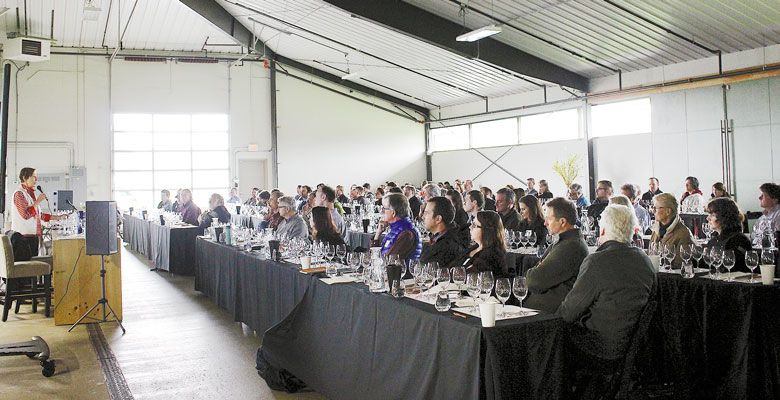Lowdown on Bubbly
Meeting addresses rising interest in Oregon sparkling
Imagine an Oregon famous “viniculturally” not for Pinot Noir or Chardonnay, but for bubbling juice. Farmer fizz, that is. Sparkling wine.
That “what if” took a step from the hypothetical to the practical at the Sparkling Wine Symposium, held Thursday, April 14, at Ponzi Winery in Sherwood. Generating excitement and commitment were the orders of the day — to create a rising tide that might lift all bubbles.
The all-day seminar was organized by the Oregon Wine Research Institute, an extension service of Oregon State University’s Department of Horticulture. The event brought together more than a hundred winemakers and grapegrowers to discuss the potential — and pitfalls — of producing more sparkling wine in the state.
General consensus is that Oregon’s cool-climate growing regions have the potential to become the New World counterpart to the Champagne region of France. The state is already renowned for its world-class Pinot Noir and Chardonnay — the two varieties that make up Grand Cru bubbles.
Also is the opportunity to capitalize on a groundswell of worldwide and local interest in sparkling wine. But Oregon producers must first overcome various technical and economic hurdles.
Costs add up.
The symposium started with a crash course in the cold, harsh economic realities of sparkling wine production.
“It’s both expensive to make and difficult to sell,” said Mark Chien, program coordinator at the Oregon Wine Research Institute.
His comment was highlighted in financial detail by the next two presenters: Mike Fisher of Global Wine Partners, and Debbie Degener, a certified public accountant with Irvine & Co., which focuses on the wine industry.
They both reported sound economic news: Global demand for sparkling wine has risen dramatically. In the U.S., domestic imports are up almost 50 percent over the past decade.
The drawback is the majority of those sparkling sales are for budget bubbles — inexpensive Prosecco and Cava. And therein lies the rub.
Oregon must uphold its tradition and reputation for making world-class still wine. If it is to make sparkling wine, it must opt for the méthode Champenoise style, which is both time- and money-consuming, costing 30 to 50 percent more and taking years longer than still wine production.
“From a financial point of view, no accountant would tell you to make sparkling wine,” Degener said, followed by a round of anxious laughter from the crowd.
Sparkling winemakers from California and France recharged the room’s enthusiasm by speaking about their experiences.
Eileen Crane, president and winemaker at Domaine Carneros in Napa, asked the attendees, “If you can’t be happy over bubbles, what can you be happy for?”
One of the “most iconic names in sparkling wine,” Crane is a true trailblazer. She entered the field in 1978 as a tour guide at Domaine Chandon, worked her way to assistant winemaker before being recruited by Champagne’s Taittinger family to develop the Domaine Carneros brand.
By California standards, Domaine Carneros is a small producer, making around 60,000 cases per year using almost all estate-grown fruit. The winery espouses a strong ethic of sustainability and a strict adherence to its brand identity, which is quite applicable to what producers might hope to accomplish here.
Addressing the challenging economics involved in making sparkling wine, Crane said, “I don’t think it’s doom and gloom for Oregon producers.” Her advice? “Keep your prices down and work with one another. There is a way to be profitable, but you must believe you can make the absolutely best sparkling wine you can.”
Sixth-generation vigneronne from France, Laureen Baillette-Prudhomme, followed Crane’s pep talk with an overview of her winemaking process, including the practice of blending juice from different vintages, which raised the question from the crowd: “If you’re blending different vintages, is the resulting wine reflective of house style or is it more terroir-driven?”
Such philosophical questions are the least of Oregon producers’ problems, however.
Technical challenges
Rollin Soles, former longtime winemaker at Oregon’s first house of bubbles, Argyle Winery, moderated the afternoon portion of the agenda. Soles has made sparkling wine in Oregon for nearly 30 years, when not many others have, and is set to launch his own sparkling wine label, RMS, later this year.
“Like layers of an onion, people talk about how many layers of sparkling wine there are, and everybody wants to make something different because there are so many working parts,” Soles said. “If you’re making a wine that has to age for three or more years, those years cause you to change your mindset about everything you do.”
Soles alluded to the steep learning curve entailed in making sparkling wine, including several tactics that simply aren’t part of making still wine. A winemaker must know instinctively when to pick grapes perfectly underripe, so that when pressed, they will become a highly acidic base wine. There’s adding the liqueur de tirage, which will trigger the in-bottle fermentation, and other critical steps along the path to bubbly bliss.
Helping winemakers overcome these technical challenges is Andrew Davis, owner of the Radiant Sparkling Wine Company.
Davis apprenticed under Soles at Argyle, then set out on his own, starting up his bubbles business in 2013 — Soles and his wife, Corby, are original investors in the venture. Davis is currently working with 15 or so wineries throughout the Willamette Valley, helping them develop their sparkling wine programs.
“We have Pinot in abundance and plenty of Chardonnay,” Davis said. “If you’re already growing [these grapes], you’re 90 percent of the way there.”
Davis and Soles next led a tasting of base wines — “lightning in a bottle,” as Davis described it.
“You have to look past the searing acidity and see the fruit. If you don’t have length, persistence of flavor, you won’t have a finish.”
“Isn’t it amazing that over the next three years, this is something that people will describe as creamy?” Soles asked. “It really requires winemakers to tweak their perception.”
The wine world may have to tweak its perception, too. While Oregon currently is known primarily for its Pinot, sparkling may soon steal the spotlight as more Oregon wineries get onboard the bubbles bandwagon.
Peter Szymczak has written about food, beverages and culinary travel for Northwest Palate, The Oregonian, Sip Northwest and other publications. He lives in the heart of wine country, Dundee.









